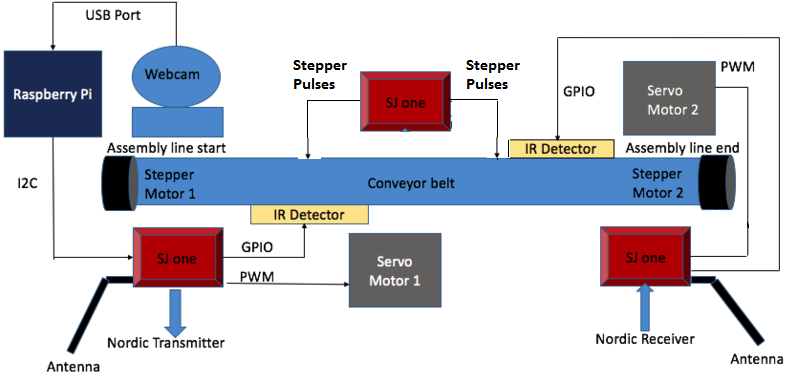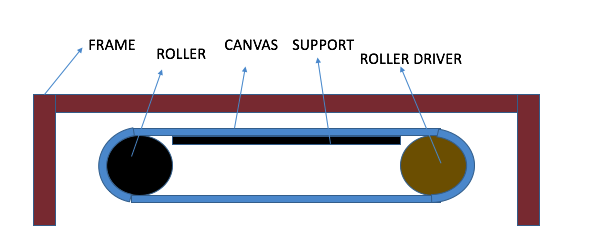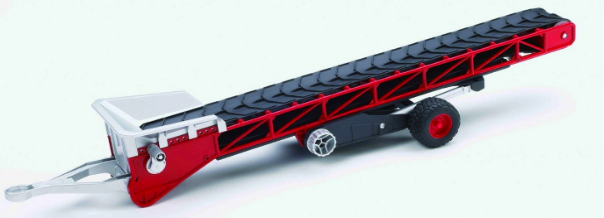S16: Helios
Contents
- 1 Grading Criteria
- 2 Automated Assembly Line
- 3 Abstract
- 4 Objectives & Introduction
- 5 Schedule
- 6 Parts List & Cost
- 7 System Block Diagram
- 8 Design & Implementation
- 9 Testing & Technical Challenges
- 10 Conclusion
- 11 References
Grading Criteria
- How well is Software & Hardware Design described?
- How well can this report be used to reproduce this project?
- Code Quality
- Overall Report Quality:
- Software Block Diagrams
- Hardware Block Diagrams
- Schematic Quality
- Quality of technical challenges and solutions adopted.
Automated Assembly Line
This project is an automated assembly line capable to defect detection, rejection and sorting with the help of wireless communication and image processing.
Abstract
The project is an automated assembly line capable of object defect detection, object rejection and sorting with the help of image processing algorithms and wireless communication. The entire system comprises of three micro controllers (2 SJOne boards and one Raspberry pi 2). A wired interface exists between raspberry pi 2 and SJOne transmitter board, while the two SJOne boards communicate via nordic wireless. Raspberry pi 2 is equipped with a linux operating system with Open CV support to run image processing algorithms for color and shape detection. All three micro controllers are mounted to a miniature assembly line with object moving on it. The SJOne transmitter board is capable of object rejection using servo motor and IR object detector module, while the SJOne receiver board is capable of simple sorting using servo motor based on the result of object color and shape detection algorithms running on raspberry pi 2.
Objectives & Introduction
- To design a automated assembly line with motor drive.
- To implement nordic wireless communication on SJOne board for communication of control signals.
- To design and implement color and shape detection algorithms using Open CV.
- To use servo motors with mechanical parts to perform object rejection and sorting.
- To be able to process images of objects on the belt and decide the acceptance of object for future processing on the assembly line.
There is a need for Assembly lines to incorporate intelligence to identify and reject defective products. Image processing is one of the foremost technologies responsible for achieving this intelligence. An assembly line with wireless and object detection, sorting capabilities is the prime goal of this project. The need for a wireless assembly line arises due to large wiring overhead in wired systems.
A camera captures the pictures of items that move on an Assembly line. The raspberry pi 2 board processes these pictures and assesses color and shape information and communicates to boards further down the aseembly line to take appropriate action. The SJOne transmitter board receives the information and rejects defective items from the assembly line while retaining fit items for the future stages of the assembly line. The SJOne receiver board uses servo motor to bifurcate the products into two separate belts based on color for future actions.
Team Members & Responsibilities
- OpenCV installation, Rasberry Pi environment setup, Hardware support
- Open CV installation support, Nordic wireless communication, Stepper and servo control, Conveyor and Hardware
Sindhuja Gopalakrishnan Elango
- Open CV algorithm design, Nordic wireless communication, Sensor implmentation, Hardware support
Akshay Dabholkar
- Open CV algorithm design,implementation and verification, Hardware support
Schedule
This section of the report provides the team schedule for the Assembly line project, indicating the milestones to be achieved during the course of the project.
| SI No. | Start Date | End Date | Task | Status | Actual Completion Date |
|---|---|---|---|---|---|
| 1 | 03/20/2016 | 03/29/2016 |
|
Completed | 03/29/2016 |
| 2 | 03/30/2016 | 04/05/2016 |
|
Completed | 04/05/2016 |
| 3 | 04/06/2016 | 04/12/2016 |
|
Completed | 04/12/2016 |
| 4 | 04/13/2016 | 04/19/2016 |
|
Completed | 04/25/2016 |
| 5 | 04/20/2016 | 04/26/2016 |
|
Completed | 05/05/2016 |
| 6 | 04/27/2016 | 05/03/2016 |
|
Completed | 05/12/2016 |
| 7 | 05/04/2016 | 05/10/2016 |
|
Incomplete | |
| 8 | 05/11/2016 | 05/17/2016 |
|
Incomplete |
Parts List & Cost
| Item# | Part Description | Vendor | Qty | Cost |
|---|---|---|---|---|
| 1 | Conveyer system | Amazon | 1 | $34.62 |
| 2 | IR Object detector | Fry's | 2 | $21.78 |
| 3 | Antenna - Wireless communication | Amazon | 2 | $10.9 |
| 4 | 5V Stepper Motor with driver break out board | Amazon | 2 | $11.98 |
| 5 | Microsoft USB HD camera | Amazon | 1 | $24.24 |
| 7 | Wire Cutter | Amazon | 1 | $2.99 |
| 8 | Hardware Items | Home Depot | 1 | $15.49 |
| Total Cost | $113.87 |
System Block Diagram
Design & Implementation
The design section can go over your hardware and software design. Organize this section using sub-sections that go over your design and implementation.
Hardware Design
Discuss your hardware design here. Show detailed schematics, and the interface here.
SJOne Board
Raspberry Pi
Conveyor Belt
Conveyor belt is a mechanical system with which materials can be transferred from one location to another. Conveyor systems are used in many industrial applications for safely transferring materials where several processing steps happen on the material when it travels on the belt. As the conveyor system is fully automated, it can be ensured to a have a uniform throughput of the deliverable. Industries thus use the conveyors for increasing their production rate. Conveyor systems are very popular in material handling, packaging, automotive, food processing and many other industries.
Webcam
Nordic wireless
IR Detector
Servo Motor
Stepper Motor
Hardware Interface
In this section, you can describe how your hardware communicates, such as which BUSes used. You can discuss your driver implementation here, such that the Software Design section is isolated to talk about high level workings rather than inner working of your project.
Interface with SJOne Master Board
Interface with SJOne Slave Board
Software Design
Show your software design. For example, if you are designing an MP3 Player, show the tasks that you are using, and what they are doing at a high level. Do not show the details of the code. For example, do not show exact code, but you may show psuedocode and fragments of code. Keep in mind that you are showing DESIGN of your software, not the inner workings of it.
Implementation
This section includes implementation, but again, not the details, just the high level. For example, you can list the steps it takes to communicate over a sensor, or the steps needed to write a page of memory onto SPI Flash. You can include sub-sections for each of your component implementation.
Testing & Technical Challenges
Describe the challenges of your project. What advise would you give yourself or someone else if your project can be started from scratch again? Make a smooth transition to testing section and described what it took to test your project.
Include sub-sections that list out a problem and solution, such as:
My Issue #1
Discuss the issue and resolution.
Conclusion
Conclude your project here. You can recap your testing and problems. You should address the "so what" part here to indicate what you ultimately learnt from this project. How has this project increased your knowledge?
Project Video
Upload a video of your project and post the link here.
Project Source Code
References
Acknowledgement
Any acknowledgement that you may wish to provide can be included here.
References Used
List any references used in project.
Appendix
You can list the references you used.


